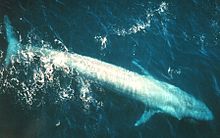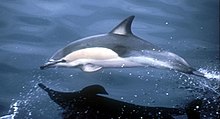
A | B | C | D | E | F | G | H | CH | I | J | K | L | M | N | O | P | Q | R | S | T | U | V | W | X | Y | Z | 0 | 1 | 2 | 3 | 4 | 5 | 6 | 7 | 8 | 9
| Ungulates Temporal range:
| |
|---|---|

| |
| Image from top to left with artiodactyls at the top and Perissodactyla at the bottom: giraffe, plains bison, dromedary, red deer, wild boar, orca (Cetacea), plains zebra, Indian rhinoceros, and Brazilian tapir. | |
| Scientific classification | |
| Domain: | Eukaryota |
| Kingdom: | Animalia |
| Phylum: | Chordata |
| Class: | Mammalia |
| Clade: | Pan-Euungulata |
| Mirorder: | Euungulata Waddell et al., 2001[1] |
| Orders and clades | |
| |
| Synonyms | |
| |
Ungulates (/ˈʌŋɡjʊleɪts, -ɡjə-, -lɪts, -ləts/ UNG-gyuu-layts, -gyə-, -lits, -ləts) are members of the diverse clade Euungulata ("true ungulates"), which primarily consists of large mammals with hooves. Once part of the clade "Ungulata" along with the clade Paenungulata, "Ungulata" has since been determined to be a polyphyletic and thereby invalid clade based on molecular data. As a result, true ungulates had since been reclassified to the newer clade Euungulata in 2001 within the clade Laurasiatheria while Paenungulata has been reclassified to a distant clade Afrotheria.[4] Living ungulates are divided into two orders: Perissodactyla including equines, rhinoceroses, and tapirs; and Artiodactyla including cattle, antelope, pigs, giraffes, camels, sheep, deer, and hippopotamuses, among others. Cetaceans such as whales, dolphins, and porpoises are also classified as artiodactyls, although they do not have hooves. Most terrestrial ungulates use the hoofed tips of their toes to support their body weight while standing or moving. Two other orders of ungulates, Notoungulata and Litopterna, both native to South America, became extinct at the end of the Pleistocene, around 12,000 years ago.
The term means, roughly, "being hoofed" or "hoofed animal". As a descriptive term, "ungulate" normally excludes cetaceans as they do not possess most of the typical morphological characteristics of other ungulates, but recent discoveries indicate that they were also descended from early artiodactyls.[5] Ungulates are typically herbivorous and many employ specialized gut bacteria to allow them to digest cellulose, though some members may deviate from this: several species of pigs and the extinct entelodonts are omnivorous, while cetaceans and the extinct mesonychians are carnivorous.
Etymology
Ungulate is from the Late Latin adjective ungulatus, 'hoofed'. Ungulatus is a diminutive form of Latin unguis, 'nail' (finger nail; toe nail).[6]
Classifications
History
Euungulata is a clade (or in some taxonomies, a grand order) of mammals. The two extant orders of ungulates are the Perissodactyla (odd-toed ungulates) and Artiodactyla (even-toed ungulates). Hyracoidea (hyraxes), Sirenia (sea cows) (dugongs and manatees) and Proboscidea (elephants) were in the past grouped within the clade "Ungulata", later found to be a polyphyletic and now invalid clade. The three orders of Paenungulata are now considered a clade and grouped in the Afrotheria clade, while Euungulata is now grouped under the Laurasiatheria clade.[1]
In 2009, morphological[7][8][9][10] and molecular[11][12] work found that aardvarks, hyraxes, sea cows, and elephants were more closely related to each other and to sengis, tenrecs, and golden moles than to the perissodactyls and artiodactyls, and form the clade Afrotheria. Elephants, sea cows, and hyraxes were grouped together in the clade Paenungulata, while the aardvark has been considered as either a close relative to them or a close relative to sengis in the clade Afroinsectiphilia.[13] This is a striking example of convergent evolution.[14]
There is now some dispute as to whether this smaller Euungulata is a cladistic (evolution-based) group, or merely a phenetic group (form taxon) or folk taxon (similar, but not necessarily related). Some studies have indeed found the mesaxonian ungulates and paraxonian ungulates to form a monophyletic lineage,[15][16][17] closely related to either the Ferae (the carnivorans and the pangolins)[18][19] in the clade Fereuungulata or to the bats.[20] Other studies found the two orders not that closely related, as some place the perissodactyls as close relatives to bats and Ferae in Pegasoferae[21] and others place the artiodactyls as close relatives to bats.[22]
Taxonomy






Below is a simplified taxonomy (assuming that ungulates do indeed form a natural grouping) with the extant families, in order of the relationships. Keep in mind that there were still some grey areas of conflict, such as the case with the relationship between the pecoran families and the baleen whale families. See each family for the relationships of the species as well as the controversies in their respective articles.
- Euungulata[15]
- Perissodactyla (Mesaxonian ungulates)
- Hippomorpha
- Equidae: Horses, asses and zebras
- Ceratomorpha
- Tapiridae: Tapirs
- Rhinocerotidae: Rhinoceroses
- Hippomorpha
- Artiodactyla (= Cetartiodactyla) (Paraxonian ungulates)
- Tylopoda
- Camelidae: Camels and llamas
- Artiofabula
- Suina
- Tayassuidae: Peccaries
- Suidae: Pigs
- Cetruminantia
- Ruminantia
- Tragulidae: Chevrotains
- Cervoidea
- Antilocapridae: Pronghorn
- Giraffidae: Giraffes and okapi
- Cervidae: Deer
- Moschidae: Musk deer
- Bovidae: Cattle and antelopes
- Whippomorpha
- Hippopotamidae: Hippopotamuses
- Cetacea
- Mysticeti
- Balaenidae: Bowhead and right whales
- Cetotheriidae: Pygmy right whale
- Balaenopteridae: Rorquals
- Odontoceti
- Physeteroidea
- Physeteridae: Sperm whale
- Kogiidae: Lesser sperm whales
- Platanistoidea
- Platanistidae: Indian river dolphins
- Ziphioidea
- Ziphiidae: Beaked whales
- Lipotoidea
- Lipotidae: Baiji (functionally extinct)
- Inioidea
- Iniidae: Amazonian river dolphins
- Pontoporiidae: La Plata dolphin
- Delphinoidea
- Monodontidae: Beluga and narwhal
- Phocoenidae: Porpoises
- Delphinidae: Oceanic dolphins
- Physeteroidea
- Mysticeti
- Ruminantia
- Suina
- Tylopoda
- Perissodactyla (Mesaxonian ungulates)
Phylogeny
Below is the general consensus of the phylogeny of the ungulate families.[22][23]



